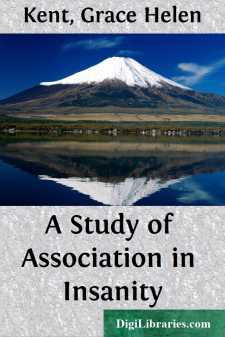Categories
- Antiques & Collectibles 13
- Architecture 36
- Art 48
- Bibles 22
- Biography & Autobiography 813
- Body, Mind & Spirit 142
- Business & Economics 28
- Children's Books 15
- Children's Fiction 12
- Computers 4
- Cooking 94
- Crafts & Hobbies 4
- Drama 346
- Education 46
- Family & Relationships 57
- Fiction 11828
- Games 19
- Gardening 17
- Health & Fitness 34
- History 1377
- House & Home 1
- Humor 147
- Juvenile Fiction 1873
- Juvenile Nonfiction 202
- Language Arts & Disciplines 88
- Law 16
- Literary Collections 686
- Literary Criticism 179
- Mathematics 13
- Medical 41
- Music 40
- Nature 179
- Non-Classifiable 1768
- Performing Arts 7
- Periodicals 1453
- Philosophy 64
- Photography 2
- Poetry 896
- Political Science 203
- Psychology 42
- Reference 154
- Religion 513
- Science 126
- Self-Help 84
- Social Science 81
- Sports & Recreation 34
- Study Aids 3
- Technology & Engineering 59
- Transportation 23
- Travel 463
- True Crime 29
A Study of Association in Insanity
by: Grace Helen Kent
Description:
Excerpt
PART I.
ASSOCIATION IN NORMAL SUBJECTS.
Among the most striking and commonly observed manifestations of insanity are certain disorders of the flow of utterance which appear to be dependent upon a derangement of the psychical processes commonly termed association of ideas. These disorders have to some extent been made the subject of psychological experimentation, and the object of this investigation is to continue and extend the study of these phenomena by an application of the experimental method known as the association test.
§ 1. METHOD OF INVESTIGATION.
In this investigation we have followed a modified form of the method developed by Sommer,[1] the essential feature of which is the statistical treatment of results obtained by uniform technique from a large number of cases.
[Footnote 1: Diagnostik der Geisteskrankheiten, p. 112.]
The stimulus consists of a series of one hundred spoken words, to each of which the subject is directed to react by the first word which it makes him think of. In the selection of the stimulus words, sixty-six of which were taken from the list suggested by Sommer, we have taken care to avoid such words as are especially liable to call up personal experiences, and have so arranged the words as to separate any two which bear an obviously close relation to one another. After much preliminary experimentation we adopted the following list of words:
01 Table 02 Dark 03 Music 04 Sickness 05 Man 06 Deep 07 Soft 08 Eating 09 Mountain 10 House 11 Black 12 Mutton 13 Comfort 14 Hand 15 Short 16 Fruit 17 Butterfly 18 Smooth 19 Command 20 Chair 21 Sweet 22 Whistle 23 Woman 24 Cold 25 Slow 26 Wish 27 River 28 White 29 Beautiful 30 Window 31 Rough 32 Citizen 33 Foot 34 Spider 35 Needle 36 Red 37 Sleep 38 Anger 39 Carpet 40 Girl 41 High 42 Working 43 Sour 44 Earth 45 Trouble 46 Soldier 47 Cabbage 48 Hard 49 Eagle 50 Stomach
No attempt is made to secure uniformity of external conditions for the test; the aim has been rather to make it so simple as to render strictly experimental conditions unnecessary. The test may be made in any room that is reasonably free from distracting influences; the subject is seated with his back toward the experimenter, so that he cannot see the record; he is requested to respond to each stimulus word by one word, the first word that occurs to him other than the stimulus word itself, and on no account more than one word. If an untrained subject reacts by a sentence or phrase, a compound word, or a different grammatical form of the stimulus word, the reaction is left unrecorded, and the stimulus word is repeated at the close of the test.
In this investigation no account is taken of the reaction time. The reasons for this will be explained later.
The general plan has been first to apply the test to normal persons, so as to derive empirically a normal standard and to determine, if possible, the nature and limits of normal variation; and then to apply it to cases of various forms of insanity and to compare the results with the normal standard, with a view to determining the nature of pathological variation....


